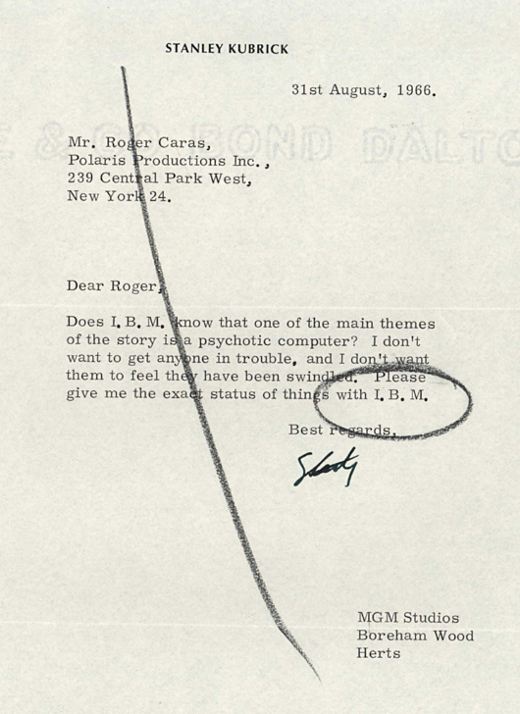“I’m sorry Dave, I’m afraid I can’t do that,” rings as a warning to mankind when we yield too much power to machines. HAL, the tyrannical computer in Stanley Kubrick’s movie, 2001: A Space Odyssey, was cleverly a one-letter shift from IBM. Recently released letters from Kubrick reveal his fear of the computing giant…

Fast-forward 50 years, and NASA’s researchers are working with IBM to develop a Watson system that could serve as a flight operations advisor (soundsfamiliar?). According to Rob High, chief technical officer for IBM Watson, over the next five to 10 years, cognitive computing systems like Watson will “be the dominant form of computing,” especially for NASA’s flight command centers.
Watson will not be alone on its mission because NASA is building an arsenal of robots in advance of human explorers to colonize MARS. This month, DARPA will put its robot crew through a series of rigorous tests. NASA is particularly interested in humanoid robots as they can either assist or act as a precursor to astronauts working in space. The USA space agency also plans to utilize the robot for space exploration missions that will involve performing tasks alongside a human crew.
NASA’s favorite “robonaut” is the Valkyrie R5 that stands at more than 6 feet tall and weighs close to 300 pounds. Valkyrie bears a striking resemblance to Iron Man with its pulsing NASA logo-blazed heart. NASA plans on shipping two Valkyrie units to government research centers to begin the trials.
“Advances in robotics, including human-robotic collaboration, are critical to developing the capabilities required for our journey to Mars,” said Steve Jurczyk, associate administrator for the STMD at NASA Headquarters in Washington. “We are excited to engage these university research groups to help NASA with this next big step in robotics technology development.”
As per the test, university principal investigators will serve as critical partners in NASA’s Space Robotics Challenge, where these two R5 units will act as instruments. The challenge is divided into two parts: a virtual competition using robotic simulations and a physical competition using the Valkyrie units. NASA’s goal is to create better AI software for dexterous humanoid robots for future space missions, enabling the bots to have more autonomy.
NASA originally designed Valkyrie to compete in DARPA’s Disaster-Relief Robotics Contest in 2015, but after losing the competition to a South Korean team, they pivoted to craft their robots into a new kind of space mechanic. There is still another two decades before NASA aims to land humans on Mars in the mid-2030s. According to Johnson Space Center spokesman Jay Bolden, now is the time to build the computer code that will make the robots useful in hostile environments. If not the Valkyries, it will be their descendants serving as the android vanguard that could make human life possible on Mars.
“It needs to be able to communicate back to Earth, very clearly and concisely, what’s going on,” said Holly Yanco, a computer science professor who directs UMass-Lowell’s robotics center and is an expert on human-robot interactions.
A time delay between communications from Earth to Mars means humans won’t be able to remotely control robots that will build structures and do emergency repair work. There’s a huge step between NASA’s robotic rover Curiosity, which landed on Mars in 2012, and the capabilities of a robot such as Valkyrie, said Robert Platt, an assistant professor at Northeastern University who is part of the research team.
“The rovers get their instructions uploaded at the beginning of the day,” Platt said. “Those instructions amount to, ‘Go over there,’ or, ‘Check out that rock.’ It’s a completely different ballgame when the job for the day is to assemble a couple of habitats.
A number of technological advancements—from faster computers to better machine-learning algorithms—will soon make it possible for a robot such as Valkyrie to perform such tasks, Platt said.
“Robotics has been making tremendous strides in the past five years. Drones, autonomous vehicles,” he said. “It’s one of those situations where you work on the same problem for decades and decades, and something finally starts to happen. Maybe this is that time.”
In other news this week, a robot escaped from a Russian science lab and caused a major traffic jam. Scientists at the Promobot Laboratories were teaching the machine how to move around independently, but it broke free after an engineer forgot to shut a gate. The robot found its way to a nearby street, covering a distance of about 165 feet before its battery ran out. According to Russian TV, which showed footage of the incident, the robot spent about 40 minutes on the lam.
Escaped robots with superhuman strength and intelligence, all in a day’s work…
Image credit: CC by NASA Goddard Space Flight Center



